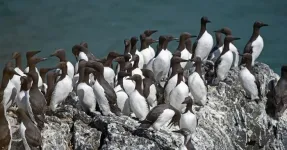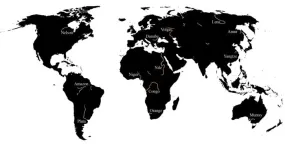(Press-News.org) The 2014-2016 Pacific marine heatwave wiped out more than half – roughly 4 million – of Alaska’s common murre (Uria aalge) seabirds, representing the largest documented vertebrate die-off linked to warming oceans, according to a new study. “Although research on the impacts of global warming on marine birds has clearly suggested major shifts in species’ ranges and abundance, documented changes have been gradual (years to decades),” write the authors. “To our knowledge, this study is the first to show that climate impacts can be swift (1 year) and intense (eliminating half of the population).” Marine heatwaves – intense, prolonged, and expansive ocean warming events – are becoming increasingly common due to climate change. They are profoundly reshaping marine ecosystems globally. These heatwaves lead to mass mortality of key habitat-forming species like kelps and corals, triggering cascading trophic effects that alter ecosystem productivity, displace lower-trophic-level species, and amplify food shortages for top predators. Although many upper-trophic-level species suffer from reduced reproductive success, increased mortality, and even mass die-offs due to marine heatwaves, broader population impacts are poorly understood. Heather Renner and colleagues evaluated the impact of the largest recorded marine heatwave in the northeast Pacific, which took place from late 2014 to 2016, on Alaska’s population of common murre seabirds. Analyzing colony counts before that period (2008-2014), and after (2016-2022), Renner et al. documented a 52-78% population decline across 13 murre colonies, equating to the loss of 4 million birds within the span of less than 2 years. According to the authors, this represents the largest documented wildlife mortality event in the modern era. Moreover, the findings reveal no evidence of population recovery since, suggesting potential long-term ecosystem shifts and an overall diminished capacity to support historical seabird populations. “We suggest that the pronounced decline of an abundant and widespread upper trophic predator to less than half of its former population size in Alaska may signal a new threshold of response to global warming,” write Renner et al.
END
Heatwave led to catastrophic and persistent loss of Alaska’s dominant seabird
Summary author: Walter Beckwith
2024-12-12
ELSE PRESS RELEASES FROM THIS DATE:
Genomic analysis refines timing of Neandertal admixture – and its impact on modern humans
2024-12-12
A genomic study encompassing more than 300 genomes spanning the last 50,000 years has revealed how a single wave of Neandertal gene flow into early modern humans left an indelible mark on human evolution. Among other findings, the study reports that modern humans acquired several Neanderthal genes that ended up being advantageous to our lineage, including those involved in skin pigmentation, immune response, and metabolism. To date, sequencing of Neanderthal and Denisovan genomes has revealed substantial gene flow between these archaic hominins ...
Superflares once per century
2024-12-12
There is no question that the Sun is a temperamental star, as alone this year’s unusually strong solar storms prove. Some of them led to remarkable auroras even at low latitudes. But can our star become even more furious? Evidence of the most violent solar “tantrums” can be found in prehistoric tree trunks and in samples of millennia-old glacial ice. However, from these indirect sources, the frequency of superflares cannot be determined. And direct measurements of the amount of radiation reaching the Earth from the Sun have only been available since the ...
A new timeline for Neanderthal interbreeding with modern humans
2024-12-12
A new analysis of DNA from ancient modern humans (Homo sapiens) in Europe and Asia has determined, more precisely than ever, the time period during which Neanderthals interbred with modern humans, starting about 50,500 years ago and lasting about 7,000 years — until Neanderthals began to disappear.
That interbreeding left Eurasians with many genes inherited from our Neanderthal ancestors, which in total make up between 1% and 2% of our genomes today.
The genome-based estimate is consistent with archeological evidence that modern humans and Neanderthals lived side-by-side in Eurasia for between 6,000 and 7,000 years. The analysis, which involved present-day human genomes ...
New timeline for Neandertal gene flow event
2024-12-12
The study of ancient DNA has greatly advanced our knowledge of human evolution, including the discovery of gene flow from Neandertals into the common ancestors of modern humans. Neandertals and modern humans diverged about 500,000 years ago, with Neandertals living in Eurasia for the past 300,000 years. Then, sometime around 40,000 to 60,000 years ago, modern human groups left Africa and spread across Eurasia, encountering Neandertals along the way. As a result, most non-Africans harbor one to two percent ...
Your immune cells are what they eat
2024-12-12
LA JOLLA (December 12, 2024)—The decision between scrambled eggs or an apple for breakfast probably won’t make or break your day. However, for your cells, a decision between similar microscopic nutrients could determine their entire identity. If and how nutrient preference impacts cell identity has been a longstanding mystery for scientists—until a team of Salk Institute immunologists revealed a novel framework for the complicated relationship between nutrition and cell identity.
The answers came while the researchers ...
Oldest modern human genomes sequenced
2024-12-12
After modern humans left Africa, they met and interbred with Neandertals, resulting in around two to three percent Neandertal DNA that can be found in the genomes of all people outside Africa today. However, little is known about the genetics of these first pioneers in Europe and the timing of the Neandertal admixture with non-Africans.
A key site in Europe is Zlatý kůň in Czechia, where a complete skull from a single individual who lived around 45,000 years ago was discovered and previously ...
Diverse virus populations coexist on single strains of gut bacteria
2024-12-12
Viruses that infect and kill bacteria, called phages, hold promise as new treatment types for dangerous infections, including strains that have become resistant to antibiotics. Yet, virologists know little about how phages persist in the populations of bacterial cells they infect, hampering the development of phage therapies.
Published online December 13 in the journal Science, a new study offers the first evidence that a single bacterial species, the host of a phage, can maintain a diverse community of competing phage species. Led by researchers at NYU Grossman ...
Surveys show full scale of massive die-off of common murres following the ‘warm blob’ in the Pacific Ocean
2024-12-12
Murres, a common seabird, look a little like flying penguins. These stout, tuxedo-styled birds dive and swim in the ocean to eat small fish and then fly back to islands or coastal cliffs where they nest in large colonies. But their hardy physiques disguise how vulnerable these birds are to changing ocean conditions.
A University of Washington citizen science program — which trains coastal residents to search local beaches and document dead birds — has contributed to a new study, led by federal scientists, documenting the devastating effect of warming waters on common murres in Alaska.
In 2020, participants of the UW-led Coastal ...
Floods, insufficient water, sinking river deltas: hydrologists map changing river landscapes across the globe
2024-12-12
AMHERST, Mass. — A new study in Science by researchers from the University of Massachusetts Amherst and University of Cincinnati has mapped 35 years of river changes on a global scale for the first time. The work has revealed that 44% of the largest, downstream rivers saw a decrease in how much water flows through them every year, while 17% of the smallest upstream rivers saw increases. These changes have implications for flooding, ecosystem disruption, hydropower development interference and insufficient freshwater supplies.
Previous attempts to quantify ...
Model enables study of age-specific responses to COVID mRNA vaccines in a dish
2024-12-12
mRNA vaccines clearly saved lives during the COVID-19 pandemic, but several studies suggest that older people had a somewhat reduced immune response to the vaccines when compared with younger adults. Why? Researchers at Boston Children’s Hospital, led by Byron Brook, PhD, David Dowling, PhD, and Ofer Levy, MD, PhD, found some answers — while providing proof-of-concept of a new system that can model mRNA vaccine responses in a dish. This, in turn, could help expedite efforts to make ...
LAST 30 PRESS RELEASES:
Injectable breast ‘implant’ offers alternative to traditional surgeries
Neuroscientists devise formulas to measure multilingualism
New prostate cancer trial seeks to reduce toxicity without sacrificing efficacy
Geometry shapes life
A CRISPR screen reveals many previously unrecognized genes required for brain development and a new neurodevelopmental disorder
Hot flush treatment has anti-breast cancer activity, study finds
Securing AI systems against growing cybersecurity threats
Longest observation of an active solar region
Why nail-biting, procrastination and other self-sabotaging behaviors are rooted in survival instincts
Regional variations in mechanical properties of porcine leptomeninges
Artificial empathy in therapy and healthcare: advancements in interpersonal interaction technologies
Why some brains switch gears more efficiently than others
UVA’s Jundong Li wins ICDM’S 2025 Tao Li Award for data mining, machine learning
UVA’s low-power, high-performance computer power player Mircea Stan earns National Academy of Inventors fellowship
Not playing by the rules: USU researcher explores filamentous algae dynamics in rivers
Do our body clocks influence our risk of dementia?
Anthropologists offer new evidence of bipedalism in long-debated fossil discovery
Safer receipt paper from wood
Dosage-sensitive genes suggest no whole-genome duplications in ancestral angiosperm
First ancient human herpesvirus genomes document their deep history with humans
Why Some Bacteria Survive Antibiotics and How to Stop Them - New study reveals that bacteria can survive antibiotic treatment through two fundamentally different “shutdown modes”
UCLA study links scar healing to dangerous placenta condition
CHANGE-seq-BE finds off-target changes in the genome from base editors
The Journal of Nuclear Medicine Ahead-of-Print Tip Sheet: January 2, 2026
Delayed or absent first dose of measles, mumps, and rubella vaccination
Trends in US preterm birth rates by household income and race and ethnicity
Study identifies potential biomarker linked to progression and brain inflammation in multiple sclerosis
Many mothers in Norway do not show up for postnatal check-ups
Researchers want to find out why quick clay is so unstable
Superradiant spins show teamwork at the quantum scale
[Press-News.org] Heatwave led to catastrophic and persistent loss of Alaska’s dominant seabirdSummary author: Walter Beckwith






